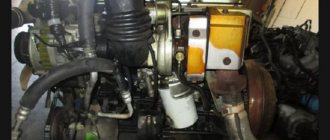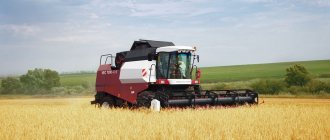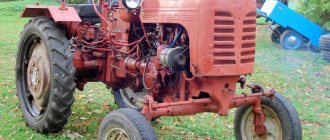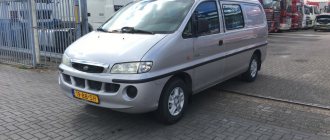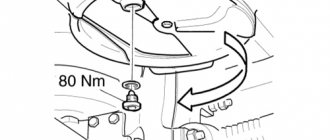The Nissan Atlas is a Japanese-made light truck, which has been in production since the end of 1981. For many years it was produced primarily for the domestic market, enjoying great demand in Japan. The European market learned about it thanks to the Renault-Nissan alliance. In addition, Atlas is very popular today in Australia, South Africa, and India, where it is regularly transported (and is also produced in India). The first models began to arrive in Russia in the late 90s (mainly vans and on-board vehicles) thanks to private merchants. Most often, Nissan Atlas can be seen on the roads of the Far East and Siberia. In addition to standard flatbed and van modifications, all over the world Nissan Atlas trucks operate as dump trucks, tow trucks, and have also proven themselves as fire engines.
Review of cars produced before 2005
Under the Atlas brand, this light truck is produced only for domestic, Japanese consumption. As it penetrated the urban freight transportation market, many modifications were created with different bodies, cabs, superstructures and engines.
Nevertheless, the main concept of this car, which was laid down by its creators, was preserved in all trim levels:
- The Nissan Atlas
chassis The spar size is 128x52x4 mm. The engine, cab, body, suspension and axles are attached to the frame. - Cabin, whatever it is - single or double, is located above the engine.
This provides good visibility of the road ahead and a small turning radius of 5 meters.Traditionally for Japanese cars of this class, the windshield is large, but this does not reduce the strength of the cabin. The side windows retained their original shape for a long time, allowing the driver to control the road situation literally under the front wheel.
- The main bodies for the first ten years were flatbeds and vans.
Cars on the Russian car market
Nissan Atlas has been produced only for the domestic Japanese market for thirty-three years. Nevertheless, in Russia, especially in the Far East and Siberia, the Nissan Atlas is very popular.
After the opportunity arose, businessmen began to import this car to Russia in large quantities. These were mainly flatbed vehicles and vans, but with the beginning of the 2000s, onboard trucks with manipulators, dump trucks and tow trucks became popular.
The price of Nissan Atlas cars for cars younger than 2007, depending on the year of manufacture and configuration, ranges from 700 thousand to 1 million 300 thousand rubles.
Base machine parameters
Main technical characteristics of the base Nissan Atlas car:
| Geometric dimensions of the car | 4 430x1 690x1 935 mm |
| Wheelbase | 2 335 mm |
| Track - front/rear | 1 400/1 390 mm |
| Wheel formula | 4×4 |
| Clearance | 180 mm |
| Number of seats in the cabin | Three |
| GVWR | 2,445 kg |
| Load capacity | 1,000 kg |
| Engine | NA16, petrol |
| Developed power | 75 l. With. |
| Engine capacity | 1.6 l |
Nissan Atlas cars were most often equipped with automatic transmissions (four- or five-speed).
The rear suspension has always been designed as a dependent suspension on springs with shock absorbers. The front suspension was mounted in different versions. It could be either independent, but with a transverse spring, or dependent, with a set of springs on both sides.
As a rule, cars with all-wheel drive, that is, with two drive axles, were made in this version.
On the first models, the brakes were installed according to the following scheme. The front is disc, the rear is drum. The brake system is dual-circuit with a vacuum booster. Steering is rack and pinion type, with built-in hydraulic booster in the base model.
The designers were concerned about safety when using this machine. Three-point seat belts and airbags are standard. The front and rear bumpers are equipped with shockproof devices.
The steering wheel in the cabin is installed on the right side, and the entire set of instruments is located according to this.
The driver's seat is designed in such a way that a person experiences minimal stress during the working day. Good lateral support and a maximum of various adjustments contribute to this.
Convenience is added by the steering column, which can be adjusted both for reach and tilt.
The cabin is provided with good air ventilation not only thanks to the lowerable side windows, but also due to the hatch installed in the cabin roof.
The improvement of the Atlas model can be traced using the example of cars produced by the Nissan concern for the period from 1990 to 2005:
- Dimensions for standard length: 4,690x1,690x1,990 mm.
- The dimensions of the machine with an average platform length are 5,990x2,000x2,115 mm.
- The geometric dimensions of the machine with a long wheelbase are 6,735x2,020x2,270 mm.
Different cab options were installed on the chassis, and this concerned not only the division into single and double.
Cabins for three people also had different sizes, both in width and height. This was done in order to increase the comfort of the driver and passengers in the cabin.
The configurations of the Atlases changed significantly. If in 1990 these were trucks and vans, then a year later a dump truck and a garbage truck were added to the list of vehicles of this brand.
Two years later, a truck appeared with a tailgate in the form of an elevator on hydraulic lifts to facilitate loading goods into the body.
In 2000, the Nissan Atlas branded car with a manipulator in the body was produced. It became possible to independently load heavy cargo into the car and transport up to 1,500 kg.
Over the course of fifteen years, twelve different engines of varying power from 75 to 155 hp were installed on Atlases in different configurations. With. Among them were both gasoline and diesel internal combustion engines. At the same time, automatics and mechanics were used as transmissions.
"Nissan Atlas" of this period in the "flatbed truck" or "van" design can be purchased at prices ranging from 200 to 750 thousand rubles.
The lineup
The Nissan Atlas model range can be called very diverse. It implies two separate categories, differing in the load capacity of the trucks produced (light and medium load capacity). The first ones are marked “F”, the second ones – “H”. Each category is represented by several generations, improvements of which are still taking place today. The predecessors of light-duty trucks are the even lighter Princ Homer and Nissan Cabstar (Nissan Atlas is still called that in Europe). The predecessors of the H series are the large and heavy Nissan Caball and Nissan Clipper.
Nissan Atlas has several types of models
In addition, there are many modifications of the Nissan Atlas as special equipment - vans, refrigerators, dump trucks, flatbed vehicles and vehicles converted into fire trucks and tow trucks. In India, this truck is even rated as a military truck, which is why it is also called the Ashok Leyland Garuda.
Low load capacity
Light duty Atlas ("F") have been produced since 1982. The cargo they are capable of transporting is 1-1.5 tons. This cargo category belongs to the following representatives of different generations.
F22 (1st generation) . The most famous model, most often called the Nissan Atlas 150. Common modifications:
- van;
- multi-stop truck - a small-tonnage vehicle used for local transportation;
- flatbed cars;
- fire truck (F100).
During production (from 1982 to 1992), both gasoline (Z16, Z20, NA16, NA 20) and diesel engines (SD25, SD23, DT23, DT27) were installed. The transmission is a manual transmission.
Atlas 150 was produced not only in Japan, but also in India. It is still very popular in the UK, where the first deliveries were sent, and in Africa.
F23 (II generation) or Nissan Atlas 10 was developed from 1992 to 2007. Unlike the previous generation, there are improvements:
- predominantly a 4-cylinder diesel engine began to be installed (DT23, DT25, DT27, KA20DE, NA20, the most powerful (3.2 l) of which is QD32);
- the transmission has been upgraded to a 4-speed automatic transmission;
- automatic windows appeared, the instrument panel was improved (previously there was no tachometer).
The exterior was changed, large windows were installed on the doors, opening up visibility. The maximum load capacity of the Nissan Atlas 10 is 1.3 tons.
F24 (III generation). The F24 marks the start of joint production of the truck with Renault due to differences in standards. In the basic, Japanese, configuration, the following improvements are noted:
- Both diesel (3 liters) and gasoline (2 liters) 4-cylinder engines are used;
- Automatic and manual transmission in 5 or 6 stages (depending on engine power);
- three categories of carrying capacity: 2, 1.75 and 1.5 tons;
- the body has been enlarged (3 or 6 seats).
One of the latest innovations is the release of the F24 with an electric motor. Most trucks have a lot of useful options (for example, installing video cameras around the vehicle, which allow the driver to comprehensively view the road situation).
Light-duty Nissan Atlas comes in 2- and 4-door versions, as can be seen in the photo. Depending on this - front-wheel drive and all-wheel drive.
Nissan Atlas is used in various fields of activity
Average load capacity
Nissan Atlas mid-duty trucks are designed for 2-4 ton loads. They are represented by the next generations.
H40 (1st generation) is the very first representative of the Nissan Atlas (200/300), produced from 1981 to 1992. Equipped exclusively with gasoline engines (Z20 and NA20), all-wheel drive. Made in India.
H41 (II generation) has been significantly modified, which can be seen in the photo - a more streamlined body, a different grille, larger side windows. A diesel engine was installed (BD30, FD42, FD46). It was produced for only 4 years.
H42 (III generation) or Nissan Atlas 20/30 began to be produced with a payload capacity increased to 3 tons. In addition, a number of design changes took place:
- a front autonomous suspension was formed;
- engines began to be installed in accordance with European gas emission standards;
- the number of lighting fixtures in the cabin has been increased;
- capacity – 3, 6, 7 passengers, including the driver.
Production stopped in 2007.
H43 (IV generation) is a diesel truck that can carry up to 4.5 tons of cargo. The developers tried to “adjust” it to European safety standards, so the exterior has been changed. Equipped with a 5 and 6 speed manual transmission. Both front-wheel drive (2-door) and all-wheel drive (4-door) modifications are available.
H44 (Vth generation) is the latest and most environmentally friendly generation, actively being developed today. H44 has a diesel engine, 5 speed manual transmission. or 6-speed automatic transmission. Maximum cargo weight – 4 tons.
Engine and its parameters
Since 2007, cars of this model of the F24 factory series have been produced with QR20DE and QR25DE engines. These are four-cylinder power units with an in-line arrangement of cylinders, the working fuel for which is gasoline.
An electronic power system with injection control ensures efficient operation of the internal combustion engine with low fuel consumption.
These engines are produced at .
QR20DE engine characteristics:
| Manufacturer | Nissan Shatai Kyushu |
| Year of issue | From 2000 to present |
| Material for making the cylinder block | Aluminum |
| Engine cylinder capacity | 1998 cc cm |
| Working cylinder diameter | 89 mm |
| Cylinder piston stroke | 80.3 mm |
| Number of valves per cylinder | four |
| Compression ratio of the working mixture in the cylinder | 9,9 |
| Developed power of internal combustion engine | 147 l. With. at 6,000 rpm |
| Maximum torque | 200 at 4,000 rpm |
| Environmental standard | Euro 4 |
| Engine life actually installed during operation | 200-250 thousand km |
| Engine operating temperature | 90 degrees |
| Type of oil poured into the internal combustion engine | 5W-30 or 5W-40 |
| The amount of oil poured into the power unit | 3.9 l, when replacing - 3.5 l |
| Oil change intervals | 15,000 km |
| Fuel consumption per 100 km | In mixed mode - 8.5 l |
The engine is filled with coolant and antifreeze, preferably made by Nissan, in an amount of 7.1 liters. In this case, in the expansion tank this liquid should be at level o. This should correspond to a volume of 0.6 liters.
The drive belt from the crankshaft pulley rotates the air conditioner, alternator, water pump and power steering. The standard spark plug used is LFR5A-11.
The engine on the Nissan Atlas works with the following electrical units:
- starter S114-844 Hitachi or MOT87081 Mitsubishi with gearbox, voltage 12 V, current less than 90 A, speed, respectively, greater than 2,700 or 2,500;
- generator SR1110-713 Hitachi, voltage 12 V, rated current - 110 A. Output voltage adjustment 14.1-14.7 V;
- battery with a capacity of 48-55 Ah.
Vehicles with KA20DE engine
The KA20DE internal combustion engine (ICE) was installed on the following Nissan models (the number is stamped on the side of the exhaust manifold at the junction of the engine and gearbox):
- Atlas 10 2000 Super Low GE-SH4F23 (1999 – 2002), TC-SH4F23 (2003 – 2005), H2F23 (1999 – 2003);
- Caravan GE-VPE25 (2001), LC-VPE25 (2005);
- Datsun GC-PD22 (1999 - 2001);
as well as on Isuzu COMO GE-JVPE25-S48D 2001 - 2003, Isuzu ELF ASH2F23, Isuzu Fargo JVPE24.
All of the listed cars are characterized by an ultra-low content of harmful substances in the exhaust gases - the engine is equipped with a LEV system (E-LEV index - emissions are 50% cleaner than the standards of 2000 and 2005). The unit runs on a mixture of air and gasoline with a ratio of 40:1.
Series 100 and 150
On the Internet, in one of the reviews about the Atlas 100 model, there is interesting information about how a car enthusiast purchased two flatbed trucks produced in 1983 at a price of 90 thousand rubles for both cars and assembled a workhorse for himself, which he still uses , and he has the best reviews about it in terms of all technical characteristics.
Models of cars produced before 1992 with F-series bodies with a carrying capacity of up to one and a half tons are often called “Nissan Atlas 150” by car owners. These cars have good dynamic and performance characteristics.
If the driver took good care of such a car, carried out timely preventive maintenance, changed oil, filters and consumables, then even when driving on our roads the car retained its positive qualities and served its owner faithfully.
Maintenance and repair
“NA” engines are not only successful for Nissan in terms of income from their sales, but also of very high quality. The two-liter engines in the line are no exception, and therefore have only positive reviews from all of their users.
Neither the NA20S nor the NA20P have any common faults. With systematic and proper maintenance, the units in question rarely break down and more than cover their service life of 300,000 - 400,000 kilometers.
If the breakdown of the NA20 could not be avoided, you can contact absolutely any service station for its repair. Many auto repair shops repair these engines, like any other from Nissan, and problems with it rarely arise.
The design and general concept of the NA20S and NA20P are fairly simple, so bringing them to life is not difficult. With the proper skill and some experience, you can even do your own repairs.
As for the modernization of the NA20s, it is quite feasible. However, it is not worth tuning these engines for at least two reasons:
- Firstly, it is not practical in terms of money. It will be possible to squeeze out no more than 120-130 horsepower from them, but the expenses will be significant.
- Secondly, the resource will drop significantly - up to 50 percent of the available one, which also makes modernization a pointless exercise.
Many motorists understand the pointlessness of improving the NA20S and NA20P, so the topic of tuning them is unpopular among them. Much more often, the owners of these engines are interested in the possibility of replacement.
As practice shows, the best option for implementing the latter would be to purchase a diesel engine from Nissan called “TD27” or its turbo version “TD27t”. They fit perfectly for all models of the manufacturer, naturally - in terms of replacing the NA20s.
Series 200
In 1993, the Nissan Atlas 200 Gate Lift model with an H41 body appeared on the list of Atlas modifications. This machine was equipped with an FD42 engine with a power of 125 hp. With.
In the same year, the Atlas 200 N41 was released with an aluminum van, with a wing-type van opening upward and with a loader crane.
The same modifications of the Nissan Atlas 200 H41 were produced in 1994-1996.
Since 2000, the numbers 10 and 20 have appeared in the Atlas names. With F-series bodies, these modifications were written as “Nissan Atlas 10 F23”.
In the period from 2007 to 2012, cars were produced under the Atlas brand with bodies of the N43 series. During this time, modifications such as a tanker truck, a sewer truck, a garbage collector, a dump truck, an on-board truck with a crane, and a fire truck were produced.
From 2007 to the present, Nissan Atlas F24 series cars have rolled off the assembly line in Japan:
- with onboard platform;
- with flatbed and double cabin;
- onboard with crane;
- side with ramp;
- refrigerated truck;
- dump truck with three-way unloading.
Which cars have the FD35 engine?
This modification is suitable for trucks, buses and specialized equipment. The manufacturer provides compatibility with the following vehicles Atlas Condor 200 300 P(U):
- CSH-40;
- DSH-40;
- SH-40;
- SYH-40;
- SBH-40;
- SQH-40;
- SGH-40.
It is not recommended to install the unit on other cars. Compatibility is a guarantee of safe movement, comfortable ride and vehicle performance.
In our online store you can purchase spare parts for the fd35 engine. Spare parts for FD35 diesel engines for trucks and cars are always in stock. Delivery to regions of Russia and the CIS by transport companies.
Go to the spare parts section
Pros of the fd35 engine
Nissan Atlas fd35 unit is compatible with different versions of the Atlas Condor and certain types of special equipment. The manufacturer was able to combine an impressive cubic capacity with an affordable price, without neglecting the quality of the automotive unit. In addition, the engine is characterized by such strengths as:
- ease of maintenance/repair;
- wear-resistant;
- anti-friction coating;
- stable work in difficult conditions;
- not picky about fuel quality;
- The cast iron structure is practically indestructible; it is not susceptible to rust, corrosion and physical damage.
Nissan fd35 is a high-quality engine with a long service life. It starts well in cold and hot conditions.
Owner reviews
“The car has been running for two years now, there were no complaints about the fd35. I didn’t notice any smoke or problems with traction or consumption. With proper maintenance, the engine works well, I am satisfied.” Victor Bausch
“I bought a used Nissan Atlas Condor, it already had an fd35. There was no need for replacement or repair, although the previous owner used the car actively. The resource is good, fuel consumption is satisfactory. If I refuel in an untrusted place, sometimes it smokes.” Andrey Kintsev
“The most important difference is that the engine starts even in the most severe frost. Naturally, I warm it up, but so far there have been no significant problems. I service it on time, fill the car with good fuel - the fd35 serves me well.” Pavel Skvortsov
Disadvantages of the FD35 engine
Despite the impressive number of advantages, there are also disadvantages. In practice, the owners noted some problems:
- increased fuel consumption;
- prone to overheating during prolonged operation;
- decline in dynamics and productivity over the years;
- compression problems;
- expensive pump (about 5000 - 7500 rubles).
Car owners have encountered shooting at maximum mode and a long start - normal acceleration is possible after 2-3 seconds of “thinking” of the engine. It can “triple” at idle after six months of operation. In this case, you need to contact a car service and check the fuel supply channels. To avoid a number of malfunctions and defects, buy the Nissan fd35 unit from official suppliers, undergo maintenance on time, and also choose the right oil for servicing the automotive unit.

